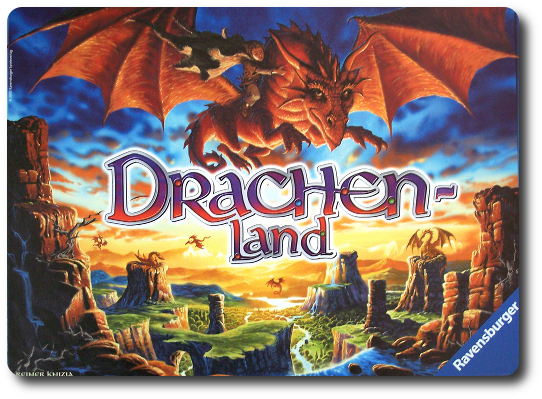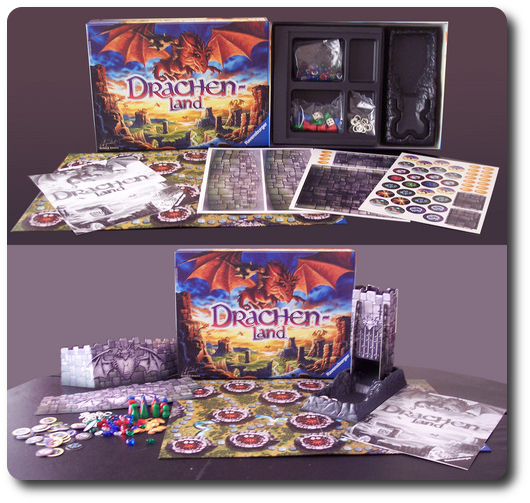
The Basics:
- For ages 8 and up (publisher suggests 9+; younger children can play the game, but will likely have problems grasping the scoring rules and special power tokens)
- For 2 to 4 players
- About 45-60 minutes to complete
Geek Skills:
- Counting & Math
- Logical & Critical Decision Making
- Color Matching
- Strategy & Tactics
Learning Curve:
- Child – Moderate
- Adult – Easy
Theme & Narrative:
- Running around in a land of volcanoes and dragons, collecting gems and dragon eggs
Endorsements:
- Gamer Geek rejected!
- Parent Geek approved!
- Child Geek approved! (barely)
Overview
Dragonland (or Drachenland) is a game by Reiner Knizia and published by Ravensburger and Rio Grande Games. Players each have 3 player pawns (one red, one green, and one blue) that they move around the board to various volcanoes to collect gems, dragon eggs, magical rings, and special power tokens.
The game board is a map of Dragonland, which is just a bunch of volcanoes separated by stone pathways. The volcanoes are randomly seeded during setup with 4 different colors of gems, dragon eggs, and special power tokens. A few rules guide the setup to make sure things are spread out interestingly.
Each player chooses a shape (not a color) and takes one green, one red, and one blue pawn of that shape, as well as 3 special power tokens. Each player also gets a cardboard wall they use to keep their collected treasures hidden.
Next to the board is the “Tower of Destiny”, which is just a basic dice tower, but thematically molded to look like a magical black obelisk. It’s actually pretty cool, but it is just a dice tower.

Photo courtesy of Board Game Geek
Players take turns rolling two dice (ahem, “Destiny Cubes”) and moving their pawns around the board. The dice are six-sided, but only have the numbers 1-4 on them. When a player rolls the dice, they use each die to move a different pawn, for a total of 2. If the pawn ends its movement on a volcano, the player automatically gets the special power token if it’s there and can then collect treasure. Collecting treasure involves some decision making, as a pawn can only collect 1 diamond, 1 egg, or all the gems that match the pawn’s color. Importantly, if the volcano has a Ring token in it, the player also gets one magic ring. The magic ring affects the final score.
Dragonland is, in fact, populated by a few dragons. One of each color matching the pawns, to be precise. They don’t really do anything dragon-like, however. They are simply there to transport pawns (of a matching color) from one volcano to another. No fire-breathing, terrorizing of villagers, or riddle asking in this game.
When all the eggs have been collected, the game ends and players add up their scores. First, every player has to make sure their pawns each have a magic ring. If one doesn’t, that player has to discard all of the gems that match that pawn’s color. Second, every egg and gem is 1 point, but every set is worth 10 points. A set is one gem of each color (red, blue, and green) and an egg. Diamonds (the clear gem) can be used as any color gem to complete a set.
The winner is the player with the most points.
Predictions
I was a little surprised when Mikayla picked this one out of the game closet. I had tried it once before with her and she hadn’t been too impressed. But that was a while ago, and she apparently had forgotten. As I pulled the game out, she asked, “Have I played this before?”
We sat down on the floor and I invited Elly, my 5-year-old, to join us. She happily did.
As soon as I opened the box, Mikayla asked if she could just play with the bits. I didn’t blame her; the gems are very cool 3-dimensional cut semi-transparent plastic beauties and the pawns are brightly painted and sturdy. The Tower of Destiny, as I said before, is also very cool.
I took a moment to refresh myself on the rules, which aren’t very many, but by the time I was done my 5-year-old was getting antsy and was ready to begin. Mikayla had already made piles of all the gemstones, separated them into clans, and was conducting some intense trade negotiations.
Time to play!
Final Word
The first few turns went by smoothly. The girls were both excited to gather different items and had no trouble with most of the rules. They weren’t very thoughtful in their choices, preferring to just go for the gems they thought were prettiest, but they did just fine.
It wasn’t until the game passed the 30 minute mark that things started to go downhill. Elly got very antsy and Mikayla started playing with some of the leftover pieces. I decided to move the game along as best I could without getting grouchy.
By the last two rounds Elly was asking, “Is it going to end soon?”
Well, it finally ended. We didn’t bother adding up the scores but Mikayla took one look at my stash and said, “You won. Easily.” Elly apparently thought it was coop game because she kept asking, “Did we all win?”
Dragonland has fantastic components and a decent scoring system. The set collection aspect and the rules that limit your ability to collect items make for some light decision points. It’s light on player interaction, though. You can’t directly affect the other players. The most you can do is grab something they’re going for or move one of the dragons away from your opponents’ pawns. You can attempt to run interference to keep another player from getting to a volcano, I suppose, but doing so would hurt you more than it would hurt them.
I think my little geeks enjoyed the game for the first 30 minutes, but it should have ended there. The turns get really repetitive after that and the game gets less interesting as volcanoes get emptied of their treasures.
I don’t think either of my daughters understood the scoring or the special power tokens. Next time we play (and I do think there will be a next time), I will try to emphasize those a little more.
All in all, this is a good game, but it does outstay its welcome a little.
Discover more from Father Geek
Subscribe to get the latest posts sent to your email.



Pingback: Father Geek’s Top 5 Games Played in 2012 » Father Geek